When someone creates something–a writer a poem, an artist a visual object–it is said they must let it go, so their readers and viewers can receive the gift and take their own meaning from it or infuse their own meaning into it.
We lead busy lives. Sometimes we don’t hear from our adult son for such a long time I begin to wonder if he remembers us. This was one of those times. But, on Christmas Tristan presented me with a knife he forged, which obviously took a long, loving while to make. It reminded me of when David and I used to make Christmas cards and presents using type he set by hand, paper we marbled, and linoleum cuts I made illustrating medieval Christmas songs. These took at least a month to craft, and the whole time we were thinking of those to whom they would be given. It made the season of gift-giving last a long, loving time.
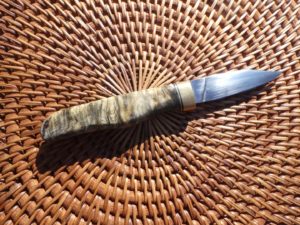
Tristan told us the beautiful handle of the knife he made of buckeye burl. He said he chose it because of an old memory: When he was in late middle or early high school David and I took him and his best friend, Jake, to White Pines Preserve at the confluence of the Rocky and Deep Rivers. He recalled when Jake started to slip down an otter slide into the river, and we hauled him back up. Shortly later he noticed I was very excited to see a buckeye tree with buckeyes on it. Why this made such an impression on him he didn’t know, but he always remembered it.
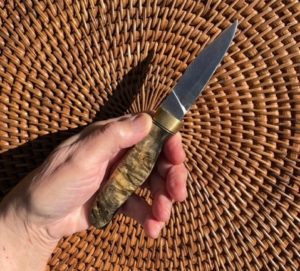
The weight, the balance of the knife, and the shape of the handle feel wonderful in the hand. I loved seeing the finished piece, but didn’t think about the making of it. When Tristan posted photos of the process as part of a series on his “knife-making journey,” I saw it grow from a piece of carbon steel and a block of wood to gradually take the shape of a knife-being as a seed germinates and grows into the shape of a tree-being.
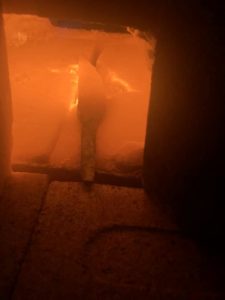


It’s true I’m enamored of buckeye trees, but I don’t think he ever saw the paintings I made of every stage of a buckeye’s growth — from the big nut-seeds with their emerging roots and twigs; through the unfurling leaves and peeking-out flower buds; to opened flowers, and finally, once pollinated, to new nuts. I un-potted a nut I planted, thinking to draw the roots, but was daunted, amazed by how long, thick, and fibrous they were. We’ve planted many buckeyes here near the creek. They stabilize and hold river banks. Last year two produced new buckeyes for the first time. Their glossy brown nuts are said to resemble the deep liquid brown eyes of a deer. Imagine encountering a deer in the woods: you are both stopped in your tracks and can’t take your eyes off each other. Then the deer stamps hard–thump–and breaks the spell.
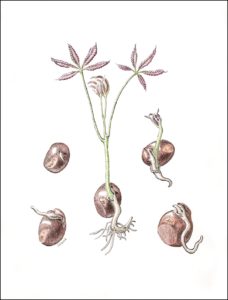
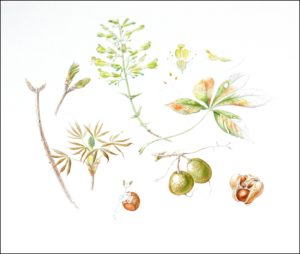
He meant it to be a paring knife, because cooking plays a big part in the family. But it’s much too exquisite for such practical use. I’m reminded of the people I made journals for when I was a bookbinder who refused to use them because, they said, they were so lovely they didn’t want to sully them with their scribblings. Sigh. The journals would only have been enhanced by their tear-stained writings. An apple would be honored to be pared by such a knife.
No, it’s a ceremonial knife. I used to have one whittled from cedar I named Intend—you know, like Bilbo’s sword that he passed on to Frodo was named Sting. Holding Intend assisted me to pray pointedly for the laser-focused attention I needed for completing an art project or to invoke the one-pointed intention I sought for a certain quest. Intend had a personality, like a faithful helper for whom I felt gratitude and affection.
Ceremonial objects are those endowed with power, like the elk-skin drum I made and infused with the power to call me home to my heart, or to call a group of us home to our deeper selves. The way the gentle clatter of a hand-crafted rattle wakes the good spirits of the land and says we’re here; please, we would like to hear back from you. Like a dried flower brought home from the funeral of a loved one continues to hold the power of love.
Objects can be active, have animacy. When our daughter was little she had a stuffed bear who helped her with her feelings. She patiently explained to me that “he can have whatever feelings I want him to have.” Whatever her feelings, he gently held them and helped her process them.
When we were visiting a museum in Moscow many years ago to see treasures of Russian Orthodox spirituality, our guide explained, with a sudden intensity and passion that seemed born of lived experience, that an icon of a saint is not just a portrait, it is a practice. In deep contemplation, it is a portal to enter into the saint’s spiritual power. Gazing into Mary’s eyes, one experiences Mary’s compassion. Gazing into a throng of angels, one enters, in trance, the angelic realm.
Holding my new carbon steel knife, BuckEye, helps me to stand tall and speak aloud my Dedication with renewed courage. Just as movement in body prayer is so much more visceral and dynamic than prayer simply spoken, a ritual object acts as an intermediary that heightens transmission between heart and Spirit. Ah, just now I see I was not far off in my knife-naming / sword-naming analogy. A cooking site, seriouseats.com, just informed me that carbon steel knives are much better than stainless, but, “Caring for a carbon-steel knife requires ritual-like devotion . . . a carbon steel blade must be treated with reverence and care like a samurai treats his sword.”
I will care for BuckEye reverently. David asked, “If it’s a ceremonial knife, does that make it an athamé,” a wiccan ritual tool? No, it will not be used to cast a magic circle, a circle within which to invite magic. For one thing, magical beings, the fairies, the Sí, don’t like iron! What it does have in common is that it will be used to draw a circle of protection, a Celtic Caim, turning in a circle while pointing to the four directions. And it is a tool of power to direct psychic energy, like making intentions. And, I will ritually consecrate it using the four elements—with the special oil Tristan gave me, infused with herbs for earth; with incense for air; and water from Brigid’s holy well. It has already been through the fire of the forge.
Come to think of it, perhaps BuckEye will have magical powers, like King Arthur’s sword Excalibur, which had the power to protect him by shining so brightly it blinded his enemies. I’m hoping BuckEye will fix me in the eye with its steely shine and magically protect my ability to set potent intentions by smiting mine enemies like laziness and distraction.
When the chaos of the outer world threatens, nothing can take away our ability to meet whatever happens with our personal powers of love and creativity. With charged energy, like ions, we can still ask potent quest-ions and take creative act-ions. New Year’s resolutions are weak, able to be easily circumvented. May we all be helped, as BuckEye will help me, to meet whatever the new year brings with strength and powerful one-pointed intent-ions.
Text and photos (C) 2023 Betty Lou Chaika. Photos of knife-making process (C) 2023 Tristan Chaika.
Deborah
Betty Lou, I loved reading this. Just wanted to wave “hi” at ya, and say that I read your newsletters and appreciate hearing about your land and your wonderful work, and it’s nice to be connected this way.
Deborah
Betty Lou Chaika
Hi back, Deborah. Speaking, in the story, of creativity and craft, another connection: Your musical performances. I love watching you dance!
Vicki Knowles
Moving and thought-provoking. Thanks for sharing your wisdom as always. How kind of your son to take the time to make something you will cherish. Those of us with Ohio State connections have been revering the Buckeye for generations; there’s even a candy named for it. But your Buckeye will be imbued with mystical powers for good. Miss you!
Vicki
Betty Lou Chaika
Hi Vicki, miss you,too. Yes, the knife our son made is already employing its positive powers. In fairy tales blacksmiths were seen as endowed with magical powers, right? The knife was wrought with love, and love is certainly, as you know, a potent magical power!
Diantha Rau
Well, thank you once again for speaking to my heart and soul. And for reminders about sacred objects, which I made for others during seven years of my life. With intention, prayer, ritual and spirit-presence, we are able to reveal the sacred throughout this physical world we live in. Thank you! Much love, Diantha
Betty Lou Chaika
Diantha, thank you for your wisdom about us being able to reveal the sacred throughout the physical world. I think that is our sacred task as humans. I so wish I had a written version of the profoundly moving stories you have told about the reverent rituals you employed in making spirit-imbued drums for people.
Ann Loomis
I’d like to know more about why fairies don’t like iron. Is that why iron horseshoes were hung over doors in the Highlands of Scotland? As a child, I had a dog named Fee, which is a derivative of “fey,” a name for fairy. Fee was a boxer dog, iron colored. Growing up in Scotland County, NC, where stories of fairies ran rampant, I always believed Fee was a fairy dog. When she had to be put down at age 11, our next dog was named Ferrous, because my older sister was taking chemistry in high school and had learned that Fe was the scientific name for iron. After Ferrous was hit by a car came Ferric. They were all iron-colored boxers. In mystic lore, dogs are considered to be “psychopomps,” or guides to the Underworld. Have we lost this mythic connection? As always, this is beautifully written and inspirational.
Betty Lou Chaika
Hi Ann, Good question! I don’t know why iron is said to repel evil. Here is some food for thought: https://sorcereroftea.com/why-does-iron-hurt-fairies/ Let’s continue to research this.
My own opinion/observation is that the Si, the faeries, come in positive and negative versions. Christianized people were afraid of magical powers that were not of the Christian God, the way people were afraid of the supposedly evil witches. But the mineral Fe, iron, is a wonderful mineral, necessary to life, neither good nor evil, so your love for your dogs was, well, love, and that’s good!
Nancy
Such a beautiful story about a beautiful knife! Thanks for writing and sharing it. I especially loved the part about the love, time, and care it takes to create such heart-felt gifts. As always, the images are lovely. May this ceremonial knife grant you any protection you need.
Betty Lou Chaika
Thanks, Nancy, for your understanding and your blessing. Yes, one of the sad results of our time-is-money culture is that we now think it is not worth it to take the time to make gifts. We have been taught that hand-made gifts are not worth the time it takes to make them. It’s true that love is not of monetary value and the knife is priceless.
Sandra
It warms my heart to read about Tristan’s forging and creation of this beautiful knife of ceremonial purpose … just for you! His love for you is imbued within the knife, so moving to me! And your ritual uses of the knife imbue it with more love and power, I believe. Thank you for sharing this LOVEly story!
Betty Lou Chaika
Thank you, Sandra, for your oft-practiced wisdom that objects can be imbued with love, and more love is added to them when they are used with love. Love grows!
Lauren
Dear Betty Lou,
I really appreciated this story about the Buckeye knife handle. I’ve had a long relationship with Buckeye for a long time and remember Buckeye trees in upper Michigan.
I have several ritual items that you might find interesting, and maybe we can share our ritual stories.
Lauren
To reply to me, you need to send me an email at my email address, which is because I wont be looking at the website.
laurenandjay@mindsprig.com
Betty Lou Chaika
Lauren, it’s sweet to hear that you love buckeye too! I’m intrigued that you have ritual items and stories to go with them. Yes, I’d love to hear what part ritual has played in your life as well.
Ann
I enjoyed reading your story and seeing your drawings. I too am very fond of buckeyes. I’m glad to see photos of the knife making process. So interesting.
Ann Gayek
Betty Lou Chaika
Hi Ann, as a fellow gardener and painter yourself, I appreciate your letting me know you enjoyed seeing the drawings as well as the knife-making process. Tristan’s gift put me in touch with how people have crafted so many wonderful items from the wood of our beautiful native trees.